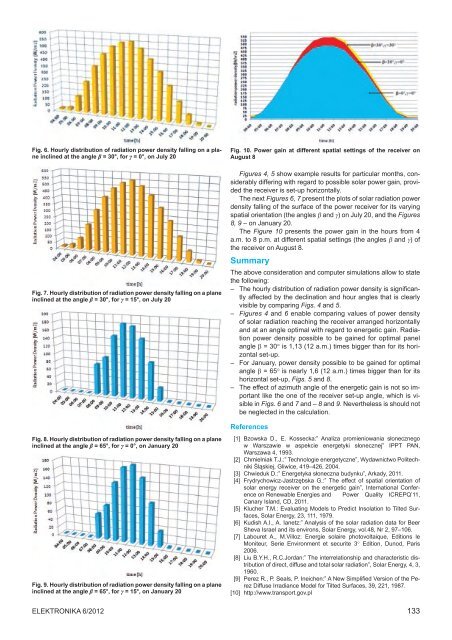Proceedings of the European Summer School of Photovoltaics 4 â 7 ...
Proceedings of the European Summer School of Photovoltaics 4 â 7 ...
Proceedings of the European Summer School of Photovoltaics 4 â 7 ...
Create successful ePaper yourself
Turn your PDF publications into a flip-book with our unique Google optimized e-Paper software.
Fig. 6. Hourly distribution <strong>of</strong> radiation power density falling on a plane<br />
inclined at <strong>the</strong> angle β = 30°, for γ = 0°, on July 20<br />
Fig. 7. Hourly distribution <strong>of</strong> radiation power density falling on a plane<br />
inclined at <strong>the</strong> angle β = 30°, for γ = 15°, on July 20<br />
Fig. 10. Power gain at different spatial settings <strong>of</strong> <strong>the</strong> receiver on<br />
August 8<br />
Figures 4, 5 show example results for particular months, considerably<br />
differing with regard to possible solar power gain, provided<br />
<strong>the</strong> receiver is set-up horizontally.<br />
The next Figures 6, 7 present <strong>the</strong> plots <strong>of</strong> solar radiation power<br />
density falling <strong>of</strong> <strong>the</strong> surface <strong>of</strong> <strong>the</strong> power receiver for its varying<br />
spatial orientation (<strong>the</strong> angles β and γ) on July 20, and <strong>the</strong> Figures<br />
8, 9 – on January 20.<br />
The Figure 10 presents <strong>the</strong> power gain in <strong>the</strong> hours from 4<br />
a.m. to 8 p.m. at different spatial settings (<strong>the</strong> angles β and γ) <strong>of</strong><br />
<strong>the</strong> receiver on August 8.<br />
Summary<br />
The above consideration and computer simulations allow to state<br />
<strong>the</strong> following:<br />
– The hourly distribution <strong>of</strong> radiation power density is significantly<br />
affected by <strong>the</strong> declination and hour angles that is clearly<br />
visible by comparing Figs. 4 and 5.<br />
– Figures 4 and 6 enable comparing values <strong>of</strong> power density<br />
<strong>of</strong> solar radiation reaching <strong>the</strong> receiver arranged horizontally<br />
and at an angle optimal with regard to energetic gain. Radiation<br />
power density possible to be gained for optimal panel<br />
angle β = 30° is 1,13 (12 a.m.) times bigger than for its horizontal<br />
set-up.<br />
– For January, power density possible to be gained for optimal<br />
angle β = 65° is nearly 1,6 (12 a.m.) times bigger than for its<br />
horizontal set-up, Figs. 5 and 8.<br />
– The effect <strong>of</strong> azimuth angle <strong>of</strong> <strong>the</strong> energetic gain is not so important<br />
like <strong>the</strong> one <strong>of</strong> <strong>the</strong> receiver set-up angle, which is visible<br />
in Figs. 6 and 7 and – 8 and 9. Never<strong>the</strong>less is should not<br />
be neglected in <strong>the</strong> calculation.<br />
References<br />
Fig. 8. Hourly distribution <strong>of</strong> radiation power density falling on a plane<br />
inclined at <strong>the</strong> angle β = 65°, for γ = 0°, on January 20<br />
Fig. 9. Hourly distribution <strong>of</strong> radiation power density falling on a plane<br />
inclined at <strong>the</strong> angle β = 65°, for γ = 15°, on January 20<br />
[1] Bzowska D., E. Kossecka:” Analiza promieniowania słonecznego<br />
w Warszawie w aspekcie energetyki słonecznej” IPPT PAN,<br />
Warszawa 4, 1993.<br />
[2] Chmielniak T.J.:” Technologie energetyczne”, Wydawnictwo Politechniki<br />
Śląskiej, Gliwice, 419–426, 2004.<br />
[3] Chwieduk D.:” Energetyka słoneczna budynku”, Arkady, 2011.<br />
[4] Frydrychowicz-Jastrzębska G.:” The effect <strong>of</strong> spatial orientation <strong>of</strong><br />
solar energy receiver on <strong>the</strong> energetic gain”, International Conference<br />
on Renewable Energies and Power Quality ICREPQ’11,<br />
Canary Island, CD, 2011.<br />
[5] Klucher T.M.: Evaluating Models to Predict Insolation to Tilted Surfaces,<br />
Solar Energy, 23, 111, 1979.<br />
[6] Kudish A.I., A. Ianetz:” Analysis <strong>of</strong> <strong>the</strong> solar radiation data for Beer<br />
Sheva Israel and its environs, Solar Energy, vol.48, Nr 2, 97–106.<br />
[7] Labouret A., M.Villoz: Energie solaire photovoltaique, Editions le<br />
Moniteur, Serie Environment et securite 3° Edition, Dunod, Paris<br />
2006.<br />
[8] Liu B.Y.H., R.C.Jordan:” The interrelationship and characteristic distribution<br />
<strong>of</strong> direct, diffuse and total solar radiation”, Solar Energy, 4, 3,<br />
1960.<br />
[9] Perez R., P. Seals, P. Ineichen:” A New Simplified Version <strong>of</strong> <strong>the</strong> Perez<br />
Diffuse Irradiance Model for Tilted Surfaces, 39, 221, 1987.<br />
[10] http://www.transport.gov.pl<br />
Elektronika 6/2012 133

















